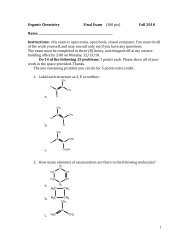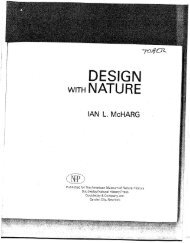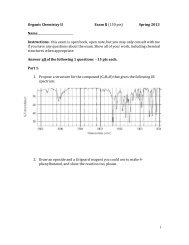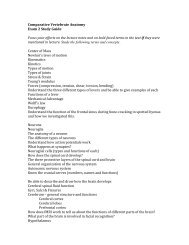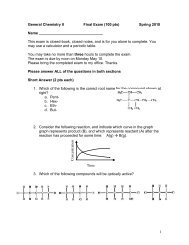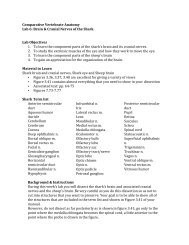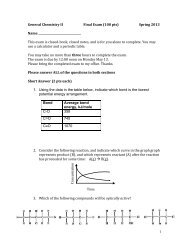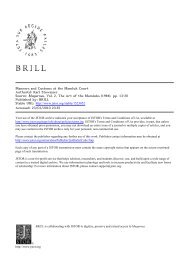Aniconism and Figural Representation in Islamic Art, by ... - Courses
Aniconism and Figural Representation in Islamic Art, by ... - Courses
Aniconism and Figural Representation in Islamic Art, by ... - Courses
Create successful ePaper yourself
Turn your PDF publications into a flip-book with our unique Google optimized e-Paper software.
<strong>Aniconism</strong> <strong>and</strong> <strong>Figural</strong> <strong>Representation</strong> <strong>in</strong> <strong>Islamic</strong> <strong>Art</strong>, <strong>by</strong> Terry Allen<br />
6/14/09 6:56 PM<br />
Five Essays on <strong>Islamic</strong> <strong>Art</strong><br />
<strong>Aniconism</strong> <strong>and</strong> <strong>Figural</strong> <strong>Representation</strong> <strong>in</strong> <strong>Islamic</strong> <strong>Art</strong><br />
<strong>by</strong> Terry Allen<br />
excerpt, without illustrations. Copyright 1988 <strong>by</strong> Solipsist Press.<br />
(back to: Palm Tree Books Home Page)<br />
(back to: description of Five Essays on <strong>Islamic</strong> <strong>Art</strong>)<br />
If <strong>Islamic</strong> art is an outgrowth of Late Antique art that does not mean that <strong>Islamic</strong> art is only late Late<br />
Antique art, or even that most of Late Antique art survives <strong>in</strong> <strong>Islamic</strong> art. The most obvious difference<br />
between the two is the lack of figural representation <strong>in</strong> <strong>Islamic</strong> religious art <strong>and</strong> a shift <strong>in</strong> the use of figural<br />
representation <strong>in</strong> secular art <strong>in</strong> the <strong>Islamic</strong> world. The difference between religious <strong>and</strong> secular usage is<br />
important to observe.<br />
Religious <strong>and</strong> Secular<br />
The Umayyad palaces of the <strong>in</strong>l<strong>and</strong> Levant, such as Mushattâ <strong>and</strong> Khirbat al-Mafjar, show that the art of the<br />
early Muslims was not entirely devoid of figural imagery (Mushattâ, triangle A; Small apsed room, Bath<br />
Hall, Khirbat al-Mafjar; Caryatid <strong>in</strong> Bath Hall entry, Khirbat al-Mafjar).<br />
It was early religious art <strong>and</strong> architecture, monuments such as the Dome of the Rock or the Great Mosque of<br />
Damascus (Dome of the Rock, <strong>in</strong>terior of the octagonal arcade, pier 5; mosaic <strong>in</strong> W arcade, Great Mosque<br />
of Damascus), that were without figural representation.<br />
The sharp difference between these two sets of monuments is not some peculiarity of Umayyad culture,<br />
peculiar though Umayyad taste may at times seem to us. Except for particularly repressive periods <strong>and</strong> the<br />
damage caused <strong>by</strong> the actions of zealots, figural representation has always been a part of secular art <strong>in</strong> the<br />
<strong>Islamic</strong> world.<br />
The twentieth century is no exception. Even the most reactionary religious regimes display <strong>in</strong> public<br />
photographs of people, particularly religio-political leaders; <strong>and</strong> when a Persian mob sacked the Moroccan<br />
embassy <strong>in</strong> Tehran <strong>in</strong> 1986 <strong>in</strong> the name of religion (the Israeli Prime M<strong>in</strong>ister hav<strong>in</strong>g just visited Rabat)<br />
photographs of K<strong>in</strong>g Hasan were burned along with Moroccan flags while photographs of Persian leaders<br />
were br<strong>and</strong>ished at the television news cameras. I found a somewhat less charged though not quite so apt<br />
example <strong>in</strong> Algiers, which experienced a heavy dose of Westernization dur<strong>in</strong>g its time under French rule<br />
between 1830 <strong>and</strong> 1962. S<strong>in</strong>ce <strong>in</strong>dependence many colonial build<strong>in</strong>gs, particularly churches, have been put<br />
to new uses. The former Church of St. Charles <strong>in</strong> Algiers has been so converted (to a mosque, I believe),<br />
<strong>and</strong> Figure 36 (Algiers, mutilated capital of porch of former Church of St. Charles) shows how one of the<br />
Roman-revival capitals of its porch, orig<strong>in</strong>ally adorned with a bust, has been mutilated so as to elim<strong>in</strong>ate<br />
the human likeness. But only a few m<strong>in</strong>utes's walk away, on one of the ma<strong>in</strong> thoroughfares of the city, the<br />
http://www.sonic.net/~tallen/palmtree/fe2.htm<br />
Page 1 of 14
<strong>Aniconism</strong> <strong>and</strong> <strong>Figural</strong> <strong>Representation</strong> <strong>in</strong> <strong>Islamic</strong> <strong>Art</strong>, <strong>by</strong> Terry Allen<br />
6/14/09 6:56 PM<br />
second-floor balconies of a late n<strong>in</strong>eteenth-century build<strong>in</strong>g sport Gibson Girl caryatids, who have been<br />
expos<strong>in</strong>g themselves to view unmolested but no doubt admired for the better part of a century (two<br />
illustrations; compare Caryatid, Bath Hall entry, Khirbat al-Mafjar).<br />
Neither representation was Algerian <strong>in</strong> orig<strong>in</strong>, <strong>and</strong> probably neither was carved <strong>by</strong> an Algerian, but their<br />
present states of conservation <strong>and</strong> destruction still represent local attitudes. There is no contradiction <strong>in</strong> the<br />
coöexistence of the caryatids <strong>and</strong> the mutilated capitals, <strong>and</strong> never has been, as one can see <strong>in</strong> the facade of<br />
Mushattâ. Mushattâ's carved decoration <strong>in</strong>cludes animal <strong>and</strong> even human representations (Mushattâ facade,<br />
triangle A) except for the portion of the facade correspond<strong>in</strong>g on the exterior of the build<strong>in</strong>g to the qiblah<br />
wall of the mosque <strong>in</strong>side, the wall on the side of Mecca, toward which prayer is directed (Mushattâ,<br />
triangle M).<br />
Illustration<br />
The decoration of that portion, <strong>and</strong> only that portion, is entirely vegetal. At Mushattâ <strong>and</strong> <strong>in</strong> Algiers the<br />
division <strong>in</strong> decoration corresponds to the division between that which perta<strong>in</strong>s directly to the practice of<br />
religion <strong>and</strong> everyth<strong>in</strong>g else.<br />
Still, these examples are sculpture, <strong>and</strong> sculpture was not a widespread form of art <strong>in</strong> the <strong>Islamic</strong> world after<br />
the Umayyads, who represent <strong>in</strong> many ways a last gasp of Late Antique art. Historical accounts <strong>in</strong>dicate that<br />
the palaces of rulers usually had public figural representations, sometimes <strong>in</strong>clud<strong>in</strong>g sculpture of some form,<br />
but for most of the population figural representation was two-dimensional <strong>and</strong> usually applied to objects of<br />
some utility.<br />
Religious <strong>Aniconism</strong><br />
The early history of Islam is recorded <strong>in</strong> oral tradition that was written down only later, when the <strong>Islamic</strong><br />
historical tradition began <strong>in</strong> the mid-eighth century. This oral tradition <strong>and</strong> the written histories that were<br />
constructed from it are difficult source material, conceal<strong>in</strong>g many problems <strong>in</strong> <strong>in</strong>terpretation. [Note: For a<br />
sharp statement of the problems see Patricia Crone, Slaves on Horses, pt. 1. ] To judge from these sources,<br />
<strong>in</strong> the early period of the development of the religion it was thought to be entirely appropriate for figural<br />
representations to occur <strong>in</strong> the context of ord<strong>in</strong>ary life <strong>and</strong> even <strong>in</strong> religious sett<strong>in</strong>gs, if those representations<br />
were not meant for religious purposes. Where there was no <strong>in</strong>tent to create an icon (for which there was<br />
supposed to be no purpose <strong>in</strong> Islam), figural imagery seems to have been unexceptionable. Thomas Arnold,<br />
writ<strong>in</strong>g <strong>in</strong> 1928, gathered material on the early <strong>Islamic</strong> use of images from historical <strong>and</strong> literary sources<br />
which shows that a creep<strong>in</strong>g iconoclasm replaced <strong>in</strong> pious doctr<strong>in</strong>e this sensible if casual practice. For<br />
example, Arnold found hadîths, or purported oral traditions about the acts <strong>and</strong> words of Muhammad, clearly<br />
support<strong>in</strong>g the secular use of images, for example the report that Muhammad objected to figural curta<strong>in</strong>s <strong>in</strong><br />
his house-cum-mosque <strong>in</strong> Madînah but was satisfied when the curta<strong>in</strong>s were cut up for cushion covers: their<br />
different orientation as cushions made them unlikely objects of prayer, <strong>and</strong> hence apparently acceptable.<br />
Whether these stories are accurate or not, they represent a straightforward <strong>and</strong> uncomplicated response to<br />
the issue. The traditional Muslim theological objection to images, which may have been observed more <strong>in</strong><br />
the breach than <strong>in</strong> ord<strong>in</strong>ary life, was eventually codified <strong>in</strong> a quite rigid form <strong>and</strong> extended to the depiction<br />
of all animate be<strong>in</strong>gs. It is captured <strong>in</strong> the prediction that "on the Day of Judgement the punishment of hell<br />
will be meted out to the pa<strong>in</strong>ter, <strong>and</strong> he will be called upon to breathe life <strong>in</strong>to the forms that he has<br />
fashioned; but he cannot breathe life <strong>in</strong>to anyth<strong>in</strong>g.... In fashion<strong>in</strong>g the form of a be<strong>in</strong>g that has life, the<br />
pa<strong>in</strong>ter is usurp<strong>in</strong>g the creative function" of God. [Note: Arnold, Pa<strong>in</strong>t<strong>in</strong>g <strong>in</strong> Islam, pp. 5--7. For secular<br />
http://www.sonic.net/~tallen/palmtree/fe2.htm<br />
Page 2 of 14
<strong>Aniconism</strong> <strong>and</strong> <strong>Figural</strong> <strong>Representation</strong> <strong>in</strong> <strong>Islamic</strong> <strong>Art</strong>, <strong>by</strong> Terry Allen<br />
6/14/09 6:56 PM<br />
examples of the use of images on objects <strong>and</strong> <strong>in</strong> architecture see Oleg Grabar, "Ceremonial <strong>and</strong> <strong>Art</strong> at the<br />
Umayyad Court," ch. 4, pp. 174ff. ] There is a clear contrast with official Byzant<strong>in</strong>e Iconoclasm on this<br />
po<strong>in</strong>t: <strong>in</strong> Byzantium it was pictures of the sa<strong>in</strong>ts, of Christ, <strong>and</strong> of God that were forbidden because they<br />
might be worshipped; these images could be replaced with scenes of the circus or hippodrome, which<br />
certa<strong>in</strong>ly do not lack animate subjects.<br />
Nor was Western European iconoclasm opposed to all figural representation: to the anonymous author of the<br />
Libri Carol<strong>in</strong>i, a collection of Lat<strong>in</strong> iconoclastic texts compiled at the Carol<strong>in</strong>gian court, "the artist was free<br />
to do what he liked... provided that he rema<strong>in</strong>ed irremediably profane." [Note: Peter Brown, "Dark Age<br />
Crisis." ] Despite later theological doctr<strong>in</strong>e, this rational division between religious <strong>and</strong> nonreligious subject<br />
matter was probably the orig<strong>in</strong>al basis of <strong>Islamic</strong> iconoclasm too, <strong>and</strong> the reasons given <strong>by</strong> the theologians<br />
were probably secondary to the orig<strong>in</strong>al motives for the nonuse of figural representations <strong>in</strong> religious<br />
contexts. That is to say, there can be an "<strong>Islamic</strong>" po<strong>in</strong>t of view on figural representation, articulated <strong>by</strong><br />
theologians <strong>and</strong> considered as foremost <strong>by</strong> the pious, that differs from "<strong>Islamic</strong>" po<strong>in</strong>ts of view held <strong>by</strong> most<br />
of the Muslim population. In view of this likely division of sentiment, which contrasts with Byzant<strong>in</strong>e<br />
iconoclasm, I prefer to term the <strong>Islamic</strong> phenomenon not iconoclasm, the rejection of images, but<br />
aniconism, the nonuse of images. The important issue for the history of art is not the eventual theological<br />
justification for <strong>Islamic</strong> aniconism but the degree of cont<strong>in</strong>uity of practice between the pre-<strong>Islamic</strong> past <strong>and</strong><br />
the early <strong>Islamic</strong> period---how people actually lived their lives <strong>in</strong> the seventh <strong>and</strong> eighth centuries---which<br />
is a matter not well h<strong>and</strong>led <strong>by</strong> our written sources.<br />
To expla<strong>in</strong> the aniconism of <strong>Islamic</strong> religious art it is necessary to set early <strong>Islamic</strong> religious art <strong>in</strong> its<br />
historical context, to underst<strong>and</strong> at least partly its manifestation <strong>in</strong> the mosque, <strong>and</strong> also to <strong>in</strong>dicate why<br />
later <strong>Islamic</strong> religious art did not cast off aniconism <strong>and</strong> adopt figural representation. (Some religious<br />
representations were certa<strong>in</strong>ly produced from at least the fifteenth century onward, particularly <strong>by</strong> the<br />
Shî`ah, but they do not constitute an established <strong>and</strong> formal practice when seen aga<strong>in</strong>st the background of<br />
cont<strong>in</strong>ued <strong>in</strong>stitutional religious aniconism.)<br />
Statues were destroyed as pagan idols <strong>in</strong> the fifth <strong>and</strong> sixth centuries <strong>in</strong> Byzantium <strong>and</strong> the Near East, just a<br />
few centuries after Constant<strong>in</strong>e ransacked the Mediterranean for antique statues to decorate his newly<br />
refounded capital. As an example of this prom<strong>in</strong>ence of statuary <strong>in</strong> the Late Antique period, the Baths of<br />
Zeuxippus <strong>in</strong> Constant<strong>in</strong>ople, a large structure located on the Hippodrome, had close to a hundred statues<br />
with<strong>in</strong> it before its destruction <strong>in</strong> the Nike riot of 532. [Note: Cyril Mango, The Brazen House, p. 39. ]<br />
Near<strong>by</strong> was the Basileios Stoa, which was evidently a public square surrounded <strong>by</strong> university build<strong>in</strong>gs,<br />
bookstores, <strong>and</strong> the like, built ca. 410, burnt <strong>and</strong> rebuilt <strong>in</strong> the fifth century, <strong>and</strong> partially burnt aga<strong>in</strong> <strong>in</strong> 532.<br />
In the sixth century it conta<strong>in</strong>ed "a gilded statue of Just<strong>in</strong>ian II <strong>in</strong> a kneel<strong>in</strong>g posture, a statue of his Khazar<br />
wife, a huge elephant together with his attendant, <strong>and</strong> a seated bronze figure of Theodosius I." [Note: Ibid.<br />
p. 50. ] The Byzant<strong>in</strong>e emperors, <strong>and</strong> others, cont<strong>in</strong>ued the antique practice of collect<strong>in</strong>g statues as art at<br />
least as late as the reign of Theodosius II (406--50), though they did not generally display them publicly.<br />
[Note: Dericksen M. Br<strong>in</strong>kerhoff, A Collection of Sculpture <strong>in</strong> Classical <strong>and</strong> Early Christian Antioch. ]<br />
While few statues were still produced, there was no lack of relief sculpture, which must have been viewed<br />
as less real <strong>and</strong> therefore less threaten<strong>in</strong>g. It was the perceived reality of sculpture that was the problem,<br />
s<strong>in</strong>ce at this date an image was identified with what it represented, <strong>in</strong> the street as well as <strong>in</strong> the church. For<br />
at the same time the population <strong>in</strong> general was com<strong>in</strong>g to regard statues as imbued with immanent magical<br />
powers. The Emperor Maurice (assass<strong>in</strong>ated 602) destroyed statues not for religious reasons but to counter<br />
their magic. This was thought to be a dangerous undertak<strong>in</strong>g requir<strong>in</strong>g considerable courage. Still, imperial<br />
statues were produced as late as the eighth century; sixth-century emperors were represented on the facade<br />
http://www.sonic.net/~tallen/palmtree/fe2.htm<br />
Page 3 of 14
<strong>Aniconism</strong> <strong>and</strong> <strong>Figural</strong> <strong>Representation</strong> <strong>in</strong> <strong>Islamic</strong> <strong>Art</strong>, <strong>by</strong> Terry Allen<br />
6/14/09 6:56 PM<br />
of the Chalke Gate, [Note: Cyril Mango, "Antique Statuary <strong>and</strong> the Byzant<strong>in</strong>e Beholder," <strong>and</strong> The Brazen<br />
House, pp. 102--07. ] the ma<strong>in</strong> entrance to the imperial palace, where an image of Christ mounted over the<br />
gate was attacked <strong>in</strong> 726 <strong>and</strong> restored only <strong>in</strong> 843 after the defeat of the Iconoclastic party. [Note: John<br />
Beckwith, The <strong>Art</strong> of Constant<strong>in</strong>ople, p. 61. ] It seems that until the Iconoclastic controvery the antagonism<br />
to public images applied only to figures that were strange or had no mean<strong>in</strong>g anymore for the man <strong>in</strong> the<br />
street with a stone <strong>in</strong> his h<strong>and</strong>.<br />
On the religious side there had been ferment over the use of images as objects of devotion for several<br />
centuries before the proclamation of Iconoclasm <strong>in</strong> 726. [Note: On this identification <strong>in</strong> prayer see Ernst<br />
Kitz<strong>in</strong>ger, "The Cult of Images before Iconoclasm." For the possibility that it was Muslim iconoclasm that<br />
touched off the outbreak of Iconoclasm as official Byzant<strong>in</strong>e doctr<strong>in</strong>e, see Patricia Crone, "Islam, Judeo-<br />
Christianity <strong>and</strong> Byzant<strong>in</strong>e Iconoclasm."] Clive Foss relates an anecdote about a late seventh-century<br />
depiction of an angel that had a label which apologized to the angel for represent<strong>in</strong>g it. [Note: Clive Foss,<br />
Ephesus After Antiquity, p. 91.] The Monophysites <strong>in</strong> particular (who <strong>in</strong> opposition to the church at<br />
Constant<strong>in</strong>ople believed that Christ had but one nature, <strong>and</strong> who constituted a large part of the Syrian<br />
population) seem to have found representations of religious entities distasteful. When Iconoclasm was<br />
declared as a policy <strong>in</strong> the Orthodox church it set off decades of serious political clashes. The way the issue<br />
was used for political purposes <strong>in</strong>dicates a similarity between the social context of Iconoclasm---that is,<br />
Byzant<strong>in</strong>e society---<strong>and</strong> <strong>Islamic</strong> society, <strong>in</strong> which politics <strong>and</strong> religion are as <strong>in</strong>tertw<strong>in</strong>ed as they often have<br />
been <strong>in</strong> countries that are formally Catholic. In all these cases government is identified with the enforcement<br />
of official religious morality.<br />
But regardless of its political overtones Byzant<strong>in</strong>e Iconoclasm cannot account for <strong>Islamic</strong> aniconism. Marlia<br />
Mundell Mango has shown that even <strong>in</strong> the sixth century the decoration of Monophysite churches <strong>in</strong> <strong>in</strong>l<strong>and</strong><br />
Syria <strong>and</strong> upper Mesopotamia---the area <strong>and</strong> sect of many Arab Christians---was entirely nonfigural. [Note:<br />
"Monophysite Church Decoration."] Thus a nonfigural <strong>Islamic</strong> religious art can be seen as cont<strong>in</strong>u<strong>in</strong>g<br />
nonfigural Arab religious art before Islam. This is not iconoclasm but aniconism.<br />
Early <strong>Islamic</strong> aniconism is specific to the mosque, a new architectural form, or group of forms, that<br />
resembles Christian <strong>and</strong> Jewish houses of worship <strong>in</strong> its general appearance but differs from them---<br />
certa<strong>in</strong>ly deliberately---<strong>in</strong> many important specifics. Whether one prefers Christian or Jewish prototypes for<br />
the mosque, the implications of the connection depend on one's answer to an almost unanswerable question:<br />
Was the mosque's likeness to the houses of worship of other monotheistic religions meant to <strong>in</strong>dicate that<br />
the mosque was also a monotheistic house of prayer, <strong>in</strong> which case its similarity to synagogues <strong>and</strong><br />
churches is primary, or was the user meant to notice the difference between the mosque <strong>and</strong> other places of<br />
worship In any event, the rectangular plan of the mosque is suited to the arrangement of worshippers <strong>in</strong><br />
rows fac<strong>in</strong>g the qiblah, but its liturgical furniture, the mihrâb or prayer niche, <strong>and</strong> m<strong>in</strong>bar or pulpit, is not.<br />
And mosques, at least early ones, do not have programmatic decorative schemes, with the partial exception<br />
of <strong>in</strong>scriptions taken from the Qur'ân. If Arab Christians before Islam had no figural images <strong>in</strong> their<br />
churches, we need not see the mosque as a near-church stripped of the images that formerly accompanied<br />
prayer, but rather as a sett<strong>in</strong>g designed without images <strong>in</strong> m<strong>in</strong>d. On this view the Muslims would have been<br />
act<strong>in</strong>g out of conviction <strong>in</strong> avoid<strong>in</strong>g the plethora of figures that characterized Byzant<strong>in</strong>e art, not, as Oleg<br />
Grabar may seem to suggest, out of a lack of choices. [Note: In Formation; for a cultural analysis somewhat<br />
<strong>in</strong> contrast to m<strong>in</strong>e see Grabar's "Islam <strong>and</strong> Iconoclasm."] After all, there is no proper <strong>Islamic</strong> equivalent to<br />
the Christian practice of prayer to a holy <strong>in</strong>tercessor, which is the po<strong>in</strong>t of a cult image <strong>in</strong> Christianity.<br />
[Note: Brown, "Dark Age Crisis," p. 270. ]<br />
So the mihrab, an empty niche with no explicit primary iconography, became the apparent focus of mosque<br />
http://www.sonic.net/~tallen/palmtree/fe2.htm<br />
Page 4 of 14
<strong>Aniconism</strong> <strong>and</strong> <strong>Figural</strong> <strong>Representation</strong> <strong>in</strong> <strong>Islamic</strong> <strong>Art</strong>, <strong>by</strong> Terry Allen<br />
6/14/09 6:56 PM<br />
decoration. In the more developed form of the mosque the antemihrab bay that <strong>in</strong>cludes the mihrab is treated<br />
as a theatrical version of the cosmos, with the structure of the heavens suggested <strong>by</strong> an <strong>in</strong>tricate design. The<br />
m<strong>in</strong>bar, the pulpit of Muhammad, is reproduced <strong>in</strong> the same bay for the prayer leader to speak from. The<br />
address given <strong>by</strong> the imam from the m<strong>in</strong>bar (the khutbah) <strong>by</strong> convention <strong>in</strong>voked the name of the ruler, <strong>and</strong><br />
the sovereign prayed near<strong>by</strong>, perhaps <strong>in</strong> order to <strong>in</strong>dicate his place <strong>in</strong> the div<strong>in</strong>e scheme. The antemihrab bay<br />
is the most decorated part of the <strong>in</strong>terior of the mosque <strong>by</strong> far, <strong>and</strong> the hypostyle structure of many early<br />
mosques ensures that it can be appreciated only when one is with<strong>in</strong> it.<br />
Thus Islam adopted a monumental sett<strong>in</strong>g for prayer composed of a mihrab, m<strong>in</strong>bar, dome over the<br />
antemihrab bay, <strong>and</strong>, beyond, a relatively unhierarchical prayer hall. As symbols, these elements are<br />
extremely understated, particularly when compared with Gothic cathedrals or H<strong>in</strong>du temples, <strong>and</strong> not only <strong>in</strong><br />
their lack of figural imagery. But what was new <strong>in</strong> the mosque as a form of religious architecture was that<br />
the formal focus of the decoration, the mihrab, was not the visual focus of the prayer hall, not that the<br />
mosque had no figural decoration. Most importantly there is no reason to th<strong>in</strong>k that the motifs, techniques,<br />
<strong>and</strong> designs that later came to be used <strong>in</strong> decorat<strong>in</strong>g the mosque orig<strong>in</strong>ated <strong>in</strong> a religious context. They were<br />
specific applications of arts that existed <strong>in</strong> secular architecture as well---<strong>and</strong> that could <strong>in</strong>clude figural<br />
components. <strong>Islamic</strong> religious aniconism applies to the mosque first <strong>and</strong> foremost.<br />
But why did the mosque rema<strong>in</strong> devoid of figural representations This question is more easily answered <strong>by</strong><br />
look<strong>in</strong>g at secular art, whose figural content also changed significantly <strong>in</strong> the transition from Late Antiquity<br />
to the <strong>Islamic</strong> era.<br />
<strong>Figural</strong> <strong>Representation</strong> <strong>in</strong> Secular <strong>Art</strong><br />
In secular <strong>Islamic</strong> art there is a shift <strong>in</strong> use of figural representation, not <strong>in</strong> the seventh century, but surely <strong>by</strong><br />
the eleventh. The Umayyad pr<strong>in</strong>ces certa<strong>in</strong>ly showed no distaste for figural art, but it seems clear that <strong>by</strong> the<br />
`Abbâsid period there had been a reduction, <strong>in</strong> both scale <strong>and</strong> physicality, <strong>in</strong> the use of figural representation<br />
<strong>in</strong> even the most lavish constructions: while the palaces of the caliphs at Samarra had frescos of danc<strong>in</strong>g<br />
girls, there is noth<strong>in</strong>g at Samarra like the carved facade of Mushattâ or the three-dimensional erotic<br />
sculpture of Khirbat al-Mafjar. This shift affects all of <strong>Islamic</strong> art, but can be seen most strongly <strong>in</strong> the<br />
Arabic-speak<strong>in</strong>g parts of the <strong>Islamic</strong> world. In the <strong>Islamic</strong> art of the Persian-speak<strong>in</strong>g world <strong>and</strong>, later,<br />
<strong>Islamic</strong> India, the most recognizable group of images conta<strong>in</strong>s representations of legendary heros, usually<br />
those of the Shâh nâmah; [Note: On narrative images of the Shâh nâmah see Marianna Shreve Simpson,<br />
"Narrative Allusion <strong>and</strong> Metaphor <strong>in</strong> the Decoration of Medieval <strong>Islamic</strong> Objects."] <strong>and</strong> <strong>in</strong> this region a<br />
tradition of f<strong>in</strong>e manuscript illustration unequalled elsewhere <strong>in</strong> <strong>Islamic</strong> art was created follow<strong>in</strong>g the<br />
Mongol <strong>in</strong>vasion of the early thirteenth century. The Arabic-speak<strong>in</strong>g world produced illustrated<br />
manuscripts too, but with only a few exceptions Arabic manuscripts are cont<strong>in</strong>uations of the Late Antique<br />
genre of scientific or luxury books <strong>and</strong> are not artistic products directly connected with literature or<br />
contemporary life. By comparison with Persian manuscript illustrations the pictures <strong>in</strong> Arabic books are not<br />
artistic successes, <strong>and</strong> they do not st<strong>and</strong> comparison as art with other forms of art <strong>in</strong> the Arabic-speak<strong>in</strong>g<br />
part of the <strong>Islamic</strong> world. The <strong>in</strong>ternal cleavage that this comparison reveals po<strong>in</strong>ts once aga<strong>in</strong> to the<br />
importance of language shar<strong>in</strong>g <strong>and</strong> language barriers for the shape of artistic developments. There are other<br />
cleavages <strong>in</strong> figural art, both <strong>in</strong> time <strong>and</strong> between genres of representation.<br />
In this discussion I shall discount early manifestations of figural representation such as Umayyad<br />
architectural decoration, along with the almost lost art of later wall pa<strong>in</strong>t<strong>in</strong>g. I shall also set aside manuscript<br />
illustration. All these th<strong>in</strong>gs strongly reflect the high status of their pre-<strong>Islamic</strong> prototypes: the illustrated<br />
http://www.sonic.net/~tallen/palmtree/fe2.htm<br />
Page 5 of 14
<strong>Aniconism</strong> <strong>and</strong> <strong>Figural</strong> <strong>Representation</strong> <strong>in</strong> <strong>Islamic</strong> <strong>Art</strong>, <strong>by</strong> Terry Allen<br />
6/14/09 6:56 PM<br />
codex, the ruler's palace, the bath. Persian manuscript illustration after the Mongol <strong>in</strong>vasion reflects, I th<strong>in</strong>k,<br />
the artistic quality of Ch<strong>in</strong>ese pa<strong>in</strong>t<strong>in</strong>g. In these th<strong>in</strong>gs the prototype is strongest, <strong>and</strong> it is an essential part<br />
of the prototype that it <strong>in</strong>cludes figural representation.<br />
I shall concentrate <strong>in</strong>stead on more common media: pottery, metalwork, <strong>and</strong> wood. These portable arts were<br />
highly developed <strong>in</strong> <strong>Islamic</strong> material culture, <strong>and</strong> display a considerable degree of similarity of decoration<br />
from one medium to another. Likewise, they follow much the same pattern <strong>in</strong> both Arabic- <strong>and</strong> Persianspeak<strong>in</strong>g<br />
spheres. Here too a differentiation of genres, or at least of types, of figural representation is<br />
neeeded.<br />
I leave aside such quasisculptural survivals of pre-<strong>Islamic</strong> prototypes as figural co<strong>in</strong>s <strong>and</strong> medals; animal<br />
protomes, f<strong>in</strong>ials, h<strong>and</strong>les, thumbstops, <strong>and</strong> legs; zoomorphic vessels <strong>and</strong> aquamaniles; <strong>and</strong> dolls. None of<br />
these is an <strong>in</strong>vention of the <strong>Islamic</strong> era, <strong>and</strong> all are quite restricted <strong>in</strong> their figural range, both <strong>in</strong> pre-<strong>Islamic</strong><br />
times <strong>and</strong> later. Much more <strong>in</strong>terest<strong>in</strong>g than objects shaped as figures is the larger <strong>and</strong> more variable class<br />
of representations applied to objects.<br />
The repertoire of representations on these portable objects features s<strong>in</strong>gle figures, figures paired, <strong>and</strong> figures<br />
displayed <strong>in</strong> emblematic fashion rather than depicted <strong>in</strong> specific moments of a known story. These emblems<br />
are often grouped <strong>in</strong> cycles <strong>and</strong> conta<strong>in</strong>ed with<strong>in</strong> nonfigural decoration, which may even dom<strong>in</strong>ate the<br />
design. Whatever mean<strong>in</strong>g they have, their context seldom suggests that they were the primary <strong>in</strong>terest of<br />
the piece on which they appear. A few categories account for most examples: <strong>in</strong>dividual animals or figures,<br />
particularly birds or horsemen (2 Persian pots); friezes or fields of animals such as dogs, fish, or<br />
ducks(another); couples seated side <strong>by</strong> side (a fourth); heros, rather than stories, from the Shâh nâmah,<br />
although stories do on occasion appear; cycles of zodiacal symbols, of planetary symbols, or of vignettes<br />
st<strong>and</strong><strong>in</strong>g for the labors of the months or seasons (Persian brass penbox, 1281, BM 42624; ivory plaque from<br />
a book cover, Cairo, 12th C, Florence, Museo Nazionale); <strong>and</strong> f<strong>in</strong>ally the so-called pr<strong>in</strong>cely cycle. [Note: A<br />
term <strong>in</strong>troduced <strong>by</strong> Grabar; see Formation, pp. 163ff. ] Fantastic creatures such as sph<strong>in</strong>xes, harpies, <strong>and</strong><br />
unicorns occur much more rarely, though just for that reason they have been studied more <strong>in</strong>tensively.<br />
[Note: Eva Baer, Sph<strong>in</strong>xes <strong>and</strong> Harpies <strong>in</strong> Medieval <strong>Islamic</strong> <strong>Art</strong>, <strong>and</strong> Richard Ett<strong>in</strong>ghausen, The Unicorn.<br />
For animals of all k<strong>in</strong>ds on metalwork see Baer, Metalwork, pp. 154--87. ]<br />
These representations seldom occur <strong>in</strong> connection with explanatory <strong>in</strong>scriptions. Most, it seems, appear on<br />
objects that carry no <strong>in</strong>scriptions at all; other figured objects have st<strong>and</strong>ardized religious <strong>in</strong>vocations <strong>and</strong><br />
<strong>in</strong>scriptions express<strong>in</strong>g generalized <strong>and</strong> conventional good wishes; still others have personalized<br />
<strong>in</strong>scriptions, with the name <strong>and</strong> titles of the customer who ordered the piece. [Note: For <strong>in</strong>vocations (du`âs)<br />
see Assadullah Souren Melikian-Chirvani, <strong>Islamic</strong> Metalwork from the Iranian World 8th--18th Centuries,<br />
pp. 29--35, <strong>and</strong> cf. my review <strong>in</strong> Ars Orientalis, v. 15, 1985 [1986]. ] Persian <strong>in</strong>scriptions have been studied<br />
more thoroughly than Arabic ones. Inscriptions on Persian luster pottery have been surveyed <strong>by</strong> Oliver<br />
Watson, who remarks a<br />
lack of relationship <strong>in</strong> general between image <strong>and</strong> <strong>in</strong>scription on both vessels <strong>and</strong> tiles. While<br />
the common image of two figures seated together may possibly be thought suitable as an<br />
illustration to some of the "love" verses (though these usually deal with the tortures of<br />
separation rather than the pleasures of the loved one's company), we also f<strong>in</strong>d such verses<br />
together with images of enthroned figures, hunters, polo players, <strong>and</strong> animals. These images are<br />
often expla<strong>in</strong>ed as part of a "pr<strong>in</strong>cely cycle" <strong>and</strong> sit ill with the tenor of the verses.<br />
Even Shâh nâmah images are coupled with what "appear to be <strong>in</strong>appropriate `love' quatra<strong>in</strong>s." [Note:<br />
http://www.sonic.net/~tallen/palmtree/fe2.htm<br />
Page 6 of 14
<strong>Aniconism</strong> <strong>and</strong> <strong>Figural</strong> <strong>Representation</strong> <strong>in</strong> <strong>Islamic</strong> <strong>Art</strong>, <strong>by</strong> Terry Allen<br />
6/14/09 6:56 PM<br />
Watson, Persian Lustre Ware, pp. 152--53. ] Watson refers to Grabar's observation that they correspond not<br />
on "a narrative <strong>and</strong> illustrative level but on some other level,... both reflect[<strong>in</strong>g] sentiments accepted as be<strong>in</strong>g<br />
appropriate to the occasion." [Note: "The Visual <strong>Art</strong>s," p. 647. ]<br />
"Correspond" may be too strong---perhaps the image <strong>and</strong> the <strong>in</strong>scriptions merely parallel each other. But<br />
otherwise this <strong>in</strong>sight is surely valid, although it does not help immediately with underst<strong>and</strong><strong>in</strong>g what the<br />
iconography of these pieces is. Watson's disappo<strong>in</strong>tment <strong>in</strong> f<strong>in</strong>d<strong>in</strong>g no greater coherence unfortunately leads<br />
him to suggest that both images <strong>and</strong> quatra<strong>in</strong>s were "imbued with religious significance" to the Shî`ah, but<br />
there is no justification for believ<strong>in</strong>g this <strong>and</strong> good reason to believe the contrary, that the images were not<br />
so important that they had to bear the k<strong>in</strong>d of mean<strong>in</strong>g Western art is accustomed to assign<strong>in</strong>g them. The<br />
same may apply to the texts: it may be that sometimes a text was to be seen <strong>and</strong> not read; that would expla<strong>in</strong><br />
why the same l<strong>in</strong>es occur repeatedly. Whatever the solution to this puzzle, it is fair to say that <strong>in</strong>scriptions<br />
do not generally expla<strong>in</strong> the figural representations they accompany.<br />
There are two separate issues to be resolved: the significance of the figural representations <strong>and</strong> their<br />
distribution, <strong>and</strong> the artistic practice of emblemization.<br />
Mean<strong>in</strong>g<br />
Much has been written on the mean<strong>in</strong>g of figural representations <strong>in</strong> the portable arts of the <strong>Islamic</strong> world,<br />
though no general <strong>in</strong>terpretation has ga<strong>in</strong>ed favor. I do not <strong>in</strong>tend to recapitulate this literature, but rather to<br />
po<strong>in</strong>t to what seem to me the most sensible <strong>in</strong>terpretative categories <strong>and</strong> how they fit together, so as to<br />
<strong>in</strong>dicate the general character of these images.<br />
Some of the isolated images seem to be apotropaic, or what one might call loosely auspicious animals. The<br />
many birds, especially on ceramics, seem to fall <strong>in</strong>to this group. Probably no provable mean<strong>in</strong>g will ever be<br />
found for them, s<strong>in</strong>ce the contemporary folklore that would expla<strong>in</strong> them has been lost.<br />
Certa<strong>in</strong> objects decorated with images of Shâh nâmah heros might have been seen as cont<strong>in</strong>u<strong>in</strong>g an ancient<br />
tradition, <strong>and</strong> the post-Sâsânian "Sâsânian silver" must belong to this group. But Shâh nâmah scenes, or at<br />
least figures, appeared on other objects as well, such as Persian luster ceramics. The mean<strong>in</strong>g of these<br />
figures is clear, even if the specific reasons they were represented on these vessels <strong>and</strong> tiles have not been<br />
expla<strong>in</strong>ed. An entirely different, <strong>and</strong> fairly large group of Fâtimid Egyptian luster bowls (some of them<br />
fakes) shows diverse human figures, evidently referr<strong>in</strong>g to real life (Cairene luster bowl, Freer, 46.30).<br />
[Note: Ett<strong>in</strong>ghausen, "Early Realism <strong>in</strong> <strong>Islamic</strong> <strong>Art</strong>." ] These, too, <strong>in</strong>vite further explanation, as do a few<br />
Persian ceramics such as a plate <strong>in</strong> the Freer Gallery published <strong>by</strong> Ett<strong>in</strong>ghausen as a Sûfî work. [Note:<br />
Grace D. Guest <strong>and</strong> Richard Ett<strong>in</strong>ghausen, "The Iconography of a Kâshân Luster Plate." ] In this latter case<br />
the <strong>in</strong>scriptions still need to be read; unfortunately the Cairene luster bowls are seldom <strong>in</strong>scribed with<br />
anyth<strong>in</strong>g but potters's names. Neither group seems to match up with works <strong>in</strong> other media.<br />
Many of the cycles refer comprehensively to the cosmos: the planets are distributed throughout the heavens,<br />
the labors of the months <strong>and</strong> seasons cover the whole year, <strong>and</strong> the zodiac encompasses both the heavens<br />
<strong>and</strong> the year. The elements of these cycles seem to be fairly simple <strong>and</strong> rout<strong>in</strong>e, though there is considerable<br />
variation among sets of cycles, particularly <strong>in</strong> the seasonal images. [Note: D. S. Rice, "The Seasons <strong>and</strong> the<br />
Labors of the Months <strong>in</strong> <strong>Islamic</strong> <strong>Art</strong>." ] A notable exception deserv<strong>in</strong>g of further analysis is the "Blacas"<br />
ewer <strong>in</strong> the British Museum, whose emblems are quite specific <strong>in</strong> their imagery, approach<strong>in</strong>g the specificity<br />
of narrative scenes ("Blacas" ewer, brass <strong>in</strong>laid with silver, Mausil, 1232, BM 6612-2961; <strong>and</strong> detail). If<br />
http://www.sonic.net/~tallen/palmtree/fe2.htm<br />
Page 7 of 14
<strong>Aniconism</strong> <strong>and</strong> <strong>Figural</strong> <strong>Representation</strong> <strong>in</strong> <strong>Islamic</strong> <strong>Art</strong>, <strong>by</strong> Terry Allen<br />
6/14/09 6:56 PM<br />
there is an <strong>in</strong>ternal logic to the specific application of one or another of these cosmic cycles to an <strong>in</strong>dividual<br />
object, such as a zodiac <strong>in</strong>dicat<strong>in</strong>g the time of year the piece was made, scholars have yet to f<strong>in</strong>d it. Less<br />
specifically, cosmic cycles may be centered on a seated figure usually <strong>in</strong>terpreted as an enthroned mortal or<br />
(or, also as) the sun, possibly <strong>in</strong> reference to the owner or user. [Note: See Baer, Metalwork, pp. 258--74. ]<br />
So it may be appropriate to <strong>in</strong>voke the evidence of the <strong>in</strong>scriptions usually found on objects. These very<br />
often are composed of good wishes, <strong>in</strong>vok<strong>in</strong>g what may appropriately be called a cycle of k<strong>in</strong>ds of wellbe<strong>in</strong>g.<br />
Similarly, then, the cosmic cycles, or <strong>in</strong>deed, any category of figural representation, may have been<br />
<strong>in</strong>tended to suggest, even to promote, cosmic well-be<strong>in</strong>g. Other associations, derived from themes of the<br />
pass<strong>in</strong>g of time, the seasons of the year, <strong>and</strong> astrology, would have been appropriate <strong>and</strong> may even have<br />
motivated the use of a cosmic cycle. James Allan has argued for a pervasive solar symbolism <strong>in</strong> <strong>in</strong>laid<br />
metalwork, a symbolism more believable for c<strong>and</strong>lesticks than for ewers. [Note: Allan, <strong>Islamic</strong> metalwork:<br />
the Nuhad es-Said Collection, pp. 46--53ff. Melikian-Chirvani sees esoteric imagery <strong>in</strong> many other places as<br />
well. ] The cycles could have been <strong>in</strong>tended to refer to the contents of the vessels on which they occur, or<br />
they could have been meant to glorify the owner or user of the vessel <strong>by</strong> glorify<strong>in</strong>g the vessel itself. In<br />
either case the owner or user obta<strong>in</strong>ed <strong>in</strong>tellectual as well as aesthetic satisfaction <strong>by</strong> putt<strong>in</strong>g the object to its<br />
<strong>in</strong>tended use.<br />
The <strong>in</strong>scriptions on these objects are not often <strong>in</strong>dicative of their use or, aside from the good wishes, of their<br />
iconography. I can see hardly any difference <strong>in</strong> the <strong>in</strong>scriptions on figural as opposed to nonfigural vessels,<br />
nor any difference between <strong>in</strong>scriptions on objects of one function <strong>and</strong> those of another. Likewise, the<br />
figural decoration seems not to be adapted to the type of vessel it decorates. In the thirteenth century<br />
<strong>in</strong>scriptions on vessels, particularly Persian ones, beg<strong>in</strong> to speak <strong>in</strong> the voice of the object, but this direct<br />
relationship between the <strong>in</strong>scription <strong>and</strong> the use of the objects is rare earlier <strong>and</strong> much more common <strong>in</strong> the<br />
fourteenth <strong>and</strong> fifteenth centuries. This lack of specific connection between <strong>in</strong>scription <strong>and</strong> function or<br />
iconography leads me to conclude that good wishes really are the basic iconography <strong>and</strong> that figural<br />
representations were simply <strong>in</strong>tended to further that theme visually. [Note: For early <strong>in</strong>scriptions <strong>in</strong> the<br />
voice of the object, see Baer, Metalwork, pp. 216--17. Allan, loc. cit., cites an <strong>in</strong>scription that clearly asks<br />
for cosmic protection for the artisan. ] Here the <strong>in</strong>scriptions do parallel the imagery. Otherwise the emphasis<br />
of the <strong>in</strong>scriptions is on the patrons who ordered the objects made <strong>and</strong> on their titulature. Are these<br />
personalized objects simply customized versions of ord<strong>in</strong>ary luxury goods, or were they made for great<br />
occasions, to commemorate the assumption of an office or a title Such a practice might expla<strong>in</strong> the large<br />
number of extant <strong>in</strong>laid metal penboxes, for example, but the distributional analysis needed to test this idea<br />
is yet to be done.<br />
The "pr<strong>in</strong>cely cycle" is clearly a separate case. In objects decorated with this cycle musicians, hunters,<br />
dancers, <strong>and</strong> cupbearers are juxtaposed with a seated figure who usually holds a cup filled, one presumes,<br />
with w<strong>in</strong>e. The earliest of these cycles on luxury objects may be the well known series of ivory boxes from<br />
Umayyad Spa<strong>in</strong>. [Note: John Beckwith, Caskets from Cordoba. ] There are many examples of such figures<br />
<strong>in</strong> Persian mînâ'î (enamelled) ceramics of the twelfth <strong>and</strong> thirteenth centuries, arranged <strong>in</strong> multifigure<br />
compositions that can be read as scenes but are actually composed of <strong>in</strong>dividual figures simply juxtaposed<br />
with each other as <strong>in</strong> any other cycle (Persian pot).<br />
The pr<strong>in</strong>cely cycle as it appears <strong>in</strong> these works must be dist<strong>in</strong>guished from the relatively <strong>in</strong>frequent objects,<br />
such as the <strong>in</strong>laid brass bas<strong>in</strong> <strong>in</strong> the Freer Gallery made <strong>in</strong> Cairo for the Ayyûbid sultan al-Malik al-Sâlih<br />
Najm al-Dîn Ayyûb about 1240 (Freer 55.10), that show friezes of "pr<strong>in</strong>cely" figures <strong>in</strong> loosely arranged<br />
groups, presented <strong>in</strong> a vaguely def<strong>in</strong>ed but apparently unitary space <strong>and</strong> not <strong>in</strong> a cyclical fashion. [Note:<br />
Most recently published <strong>by</strong> Es<strong>in</strong> Atil, <strong>Islamic</strong> Metalwork <strong>in</strong> the Freer Gallery of <strong>Art</strong>, pp. 137--46. They are<br />
http://www.sonic.net/~tallen/palmtree/fe2.htm<br />
Page 8 of 14
<strong>Aniconism</strong> <strong>and</strong> <strong>Figural</strong> <strong>Representation</strong> <strong>in</strong> <strong>Islamic</strong> <strong>Art</strong>, <strong>by</strong> Terry Allen<br />
6/14/09 6:56 PM<br />
not the source of the pr<strong>in</strong>cely cycle: D. S. Rice thought the earliest such frieze show<strong>in</strong>g a procession to be<br />
on the shoulder of a ewer made ca. 1200 <strong>in</strong> Mosul, "Studies <strong>in</strong> <strong>Islamic</strong> Metalwork---II," pp. 73--79; Eva<br />
Baer publishes a mid-fourteenth century bowl with a frieze illustrat<strong>in</strong>g a Shâh nâmah scene <strong>in</strong> Metalwork,<br />
pp. 277--79. ] An entire group of fourteenth-century south Persian <strong>in</strong>laid metalwork has similar unitary<br />
scenes. [Note: Discussed <strong>in</strong> detail <strong>by</strong> Melikian-Chirvani, op. cit., ch. 3. Several such pieces are illustrated <strong>in</strong><br />
color <strong>by</strong> Atil, Renaissance of Islam. ] Once aga<strong>in</strong> these groups f<strong>in</strong>d no parallel <strong>in</strong> other media. The<br />
iconography of these friezes may be the same as, or at least related to, that of the pr<strong>in</strong>cely cycle, but their<br />
presentation is quite different. I shall set these friezes aside, like the Shâh nâmah representations, on the<br />
assumption that they are not relevant to the ma<strong>in</strong> artistic development of emblemization <strong>and</strong> not<br />
characteristic of the <strong>Islamic</strong> portable arts more generally.<br />
S<strong>in</strong>ce the identifiable cosmic cycles are tightly organized with clearly coöord<strong>in</strong>ate emblems, it is tempt<strong>in</strong>g to<br />
see the pr<strong>in</strong>cely cycle as unanalyzed residue, which need not be understood as an entity. But elements of it<br />
occur often enough <strong>in</strong> works of high quality, <strong>and</strong> therefore high self-awareness, that some mean<strong>in</strong>g probably<br />
existed for it. [Note: Melikian-Chirvani, op. cit., p. 141, suggests that <strong>in</strong> the pr<strong>in</strong>cely cycle "the literary<br />
themes of bazm-o-razm, `feast<strong>in</strong>g <strong>and</strong> fight<strong>in</strong>g,' are illustrated systematically," but he provides no literary<br />
citations. ] S<strong>in</strong>ce the pr<strong>in</strong>cely cycle shows a variety of human recreations, apparently fairly st<strong>and</strong>ard at any<br />
one time <strong>and</strong> place, as the plantary symbols were, it would be sensible to see it as somehow a humanized<br />
version of the cosmic cycles. Indeed, to judge from its use, the pr<strong>in</strong>cely cycle could be another cosmic cycle<br />
whose symbolism has not been guessed <strong>by</strong> modern scholars. S<strong>in</strong>ce most of the pr<strong>in</strong>cely cycle images appear<br />
on objects that would have been used <strong>in</strong> social situations, it may be that the <strong>in</strong>tention was to lend the social<br />
occasions the quality of the occupations depicted <strong>in</strong> the cycle. The psychology of the pr<strong>in</strong>cely cycle seems<br />
to go beyond (or differ from) that of the cosmic cycles, which suggest harmony with or <strong>in</strong>voke the<br />
protection of the world <strong>in</strong>dicated <strong>by</strong> the emblematic figures; the pr<strong>in</strong>cely cycle identifies the owner or user<br />
with whatever it is the figures themselves are do<strong>in</strong>g.<br />
Grabar, follow<strong>in</strong>g Herzfeld, has argued that the pr<strong>in</strong>cely cycle depicts the pastimes of monarchs, especially<br />
the royal feast, as a way of <strong>in</strong>dicat<strong>in</strong>g their imperial status. Dr<strong>in</strong>k<strong>in</strong>g, listen<strong>in</strong>g to s<strong>in</strong>gers <strong>and</strong> poets,<br />
watch<strong>in</strong>g female dancers, <strong>and</strong> hunt<strong>in</strong>g are all recreations belong<strong>in</strong>g to this imperial cycle, which existed<br />
already <strong>in</strong> Sâsânian art, as seen <strong>in</strong> the cave reliefs at Tâq-i Bustân; it was developed further <strong>in</strong> the Umayyad<br />
period. [Note: Grabar, "Ceremonial <strong>and</strong> <strong>Art</strong> at the Umayyad Court," pp. 81--90 <strong>and</strong> ch. 4, esp. pp. 223--24,<br />
focuss<strong>in</strong>g on hunt<strong>in</strong>g; p. 94 for the royal feast. These views are adumbrated <strong>in</strong> Formation, pp. 163--64. ] But<br />
pastimes such as music <strong>and</strong> the hunt did not belong solely to monarchs: while good historical sources say<br />
that the Umayyad caliphs drank alone when <strong>in</strong> assembly, these texts may well reflect the etiquette of formal<br />
occasions, rather than everyday custom, <strong>and</strong> dr<strong>in</strong>k<strong>in</strong>g may have been commonplace under the Umayyads,<br />
which is evidently when the pr<strong>in</strong>cely cycle was formed (after all, the norm aga<strong>in</strong>st which new <strong>Islamic</strong> values<br />
were promulgated was the free consumption of w<strong>in</strong>e, not abstention). It was not the mere consumption of<br />
w<strong>in</strong>e that made dr<strong>in</strong>k<strong>in</strong>g a royal action for the Sâsânians <strong>and</strong> the Umayyads but rather its consumption <strong>in</strong><br />
the context of the royal feast. More generally, the emblems of the pr<strong>in</strong>cely cycle are the <strong>in</strong>dications of<br />
success, wealth, <strong>and</strong> cultural or political security. The world referred to here is the world of secular selfcelebration,<br />
<strong>and</strong> it must have had wider appeal as imagery than a strictly imperial explanation can give it.<br />
Grabar's explanation of the pr<strong>in</strong>cely cycle as related to the Umayyad court is satisfy<strong>in</strong>g because it helps to<br />
account for the extensive iconographic assemblages of the Umayyad palaces, which range far beyond mere<br />
cycles, though they seldom seem to be narrative. But other wealthy <strong>in</strong>dividuals pursued the same<br />
recreations, <strong>and</strong> may have adopted the pr<strong>in</strong>cely cycle as well.<br />
In view of the consistency with which the Umayyads equipped their rural palaces with baths on the Roman<br />
http://www.sonic.net/~tallen/palmtree/fe2.htm<br />
Page 9 of 14
<strong>Aniconism</strong> <strong>and</strong> <strong>Figural</strong> <strong>Representation</strong> <strong>in</strong> <strong>Islamic</strong> <strong>Art</strong>, <strong>by</strong> Terry Allen<br />
6/14/09 6:56 PM<br />
model, it is <strong>in</strong>terest<strong>in</strong>g that no representation of bath<strong>in</strong>g appears to have been made part of the pr<strong>in</strong>cely<br />
cycle; this is perhaps proof that the cycle is <strong>in</strong>herited from the Sâsânians <strong>and</strong> not <strong>in</strong>vented <strong>in</strong> the <strong>Islamic</strong><br />
period, but may also reflect a lack of Late Antique bath imagery, or perhaps <strong>in</strong>dicate that mere bath<strong>in</strong>g was<br />
no status symbol. Bathers or no, the pr<strong>in</strong>cely cycle never lost its popularity dur<strong>in</strong>g the period considered<br />
here.<br />
The emblems of the pr<strong>in</strong>cely cycle, then, seem not to refer to abstract entities such as signs of the zodiac,<br />
but to a set of activities that are somehow appropriate to either the use of the object on which they appear or<br />
to its user. This iconography establishes harmony rather than <strong>in</strong>vok<strong>in</strong>g protection; perhaps one should<br />
conclude that the cosmic cycles should be read the same way, as <strong>in</strong>dicat<strong>in</strong>g the harmony between the<br />
decorated object, its contents, or its user, <strong>and</strong> the cosmos as represented emblematically.<br />
Whatever their true nature, it is clear that <strong>in</strong> most cases the images of the pr<strong>in</strong>cely cycle are as emblemized<br />
as those of any other cycle: the hunt does not take place <strong>in</strong> the same time or space as the dr<strong>in</strong>k<strong>in</strong>g party with<br />
s<strong>in</strong>gers <strong>and</strong> dancers. And the pr<strong>in</strong>cely cycle need not be presented as a cycle: <strong>in</strong>dividual figures apparently<br />
drawn from the pr<strong>in</strong>cely cycle (such as women with some object <strong>in</strong> h<strong>and</strong>) occur on Persian luster bowls, <strong>and</strong><br />
may have been <strong>in</strong>tended to refer to the iconography of the entire cycle. The same po<strong>in</strong>t recurs: on these<br />
<strong>Islamic</strong> objects representation is broken <strong>in</strong>to emblems.<br />
I have narrowed the range of my discussion of emblems <strong>by</strong> discard<strong>in</strong>g s<strong>in</strong>gle figures <strong>and</strong> representations of<br />
literary characters, <strong>and</strong> <strong>by</strong> ignor<strong>in</strong>g unusual <strong>in</strong>scriptions <strong>and</strong> certa<strong>in</strong> classes of objects. Thus the evidentiary<br />
base for my conclusions is narrow, <strong>and</strong> is probably skewed <strong>by</strong> the patterns of traditional scholarship on<br />
<strong>Islamic</strong> art---that is, <strong>by</strong> what is known already. Further <strong>in</strong>vestigation depends on f<strong>in</strong>d<strong>in</strong>g groups of objects<br />
whose imagery exp<strong>and</strong>s or crosscuts my categories of underst<strong>and</strong><strong>in</strong>g, or <strong>by</strong> show<strong>in</strong>g that the categories I<br />
have set aside are connected <strong>in</strong> their mean<strong>in</strong>g with categories I have discussed. Another caveat arises from<br />
the fact that the best works artistically are often more sophisticated iconographically: the "Blacas" ewer is a<br />
good example. Can one claim that the atypical but unusually good object is evidence for the hidden mean<strong>in</strong>g<br />
of objects of ord<strong>in</strong>ary quality Where the objects concerned were created primarily as art (Western oil<br />
pa<strong>in</strong>t<strong>in</strong>gs, for example), <strong>in</strong>deed one can. But when the objects are pottery bowls, metal ewers, artfully<br />
designed objects of common use <strong>and</strong> st<strong>and</strong>ard shape, the argument from quality may be turned around, <strong>and</strong><br />
it is just as reasonable to conclude that the uniqueness of high-quality pieces is the result of extra attention<br />
to the circumstances of their patrons, a view that is confirmed <strong>by</strong> the concentration of personalized<br />
<strong>in</strong>scriptions on high-quality work.<br />
Emblemization<br />
Whatever one is to make of my conclusions regard<strong>in</strong>g the iconography of emblemized figures, it is pla<strong>in</strong> to<br />
see that the representations considered above occur on objects of secular use, refer to nonreligious ideas or<br />
entities, <strong>and</strong> are accompanied <strong>by</strong> <strong>in</strong>scriptions that, whatever the religious tone of their phraseology, do not<br />
generally <strong>in</strong>clude the phrase b-ism allâh, "<strong>in</strong> the name of God." There is no reason to suppose that<br />
emblemization is a result of aniconism <strong>in</strong> the religious sphere. How does it relate to the history of figural<br />
representation <strong>in</strong> the art of the pre-<strong>Islamic</strong> world<br />
In Antiquity figural representation was turned to several uses, which may overlap: generalized<br />
representations of types; images of identifiable characters such as gods, personifications, or literary<br />
characters; portraits (which are also identifiable characters but have features based more closely on real life);<br />
scenes from literary texts or stories, presented separately or arranged <strong>in</strong> cycles; <strong>and</strong> scenes relat<strong>in</strong>g directly<br />
http://www.sonic.net/~tallen/palmtree/fe2.htm<br />
Page 10 of 14
<strong>Aniconism</strong> <strong>and</strong> <strong>Figural</strong> <strong>Representation</strong> <strong>in</strong> <strong>Islamic</strong> <strong>Art</strong>, <strong>by</strong> Terry Allen<br />
6/14/09 6:56 PM<br />
to real life, aga<strong>in</strong> arranged separately or <strong>in</strong> cycles. Identifiable characters <strong>in</strong> <strong>Islamic</strong> art do not <strong>in</strong>clude gods,<br />
of course, but may <strong>in</strong>clude personifications or literary characters. Portraiture, too, is hardly to be found <strong>in</strong><br />
<strong>Islamic</strong> art (one might cite author portraits <strong>and</strong> early co<strong>in</strong>s, but these are cont<strong>in</strong>uations of antique types). But<br />
then portraiture had dim<strong>in</strong>ished <strong>in</strong> importance already <strong>in</strong> Late Antiquity. Emblemization is a prime feature<br />
of Late Antique art, <strong>and</strong> it is convenient to cite as examples the emblemata of floor mosaics, mosaics that<br />
conta<strong>in</strong> the seeds of the <strong>Islamic</strong> artistic <strong>in</strong>terest <strong>in</strong> geometry as well as those of the arabesque (Floor mosaic<br />
from al-Jîm, Tunisia, fourth century).<br />
A more <strong>in</strong>terest<strong>in</strong>g comparison, however, is between the emblemized <strong>Islamic</strong> cycles <strong>and</strong> antique narrative<br />
cycles.<br />
Richard Brilliant, <strong>in</strong> deal<strong>in</strong>g with visual narratives <strong>in</strong> ancient art, po<strong>in</strong>ts out the importance of "scene<br />
mak<strong>in</strong>g" for convey<strong>in</strong>g the story be<strong>in</strong>g told. [Note: Visual Narratives: Storytell<strong>in</strong>g <strong>in</strong> Etruscan <strong>and</strong> Roman<br />
<strong>Art</strong>, pp. 17--18. ] Narrative can occur with<strong>in</strong> a scene or <strong>in</strong> groups of scenes. In any s<strong>in</strong>gle scene visual<br />
details (props or gestures) identify the characters <strong>and</strong> their sett<strong>in</strong>g, <strong>and</strong> if these details do not specify the<br />
event be<strong>in</strong>g depicted the characters must exist <strong>in</strong> a composition that <strong>in</strong>dicates or refers to a known story. A<br />
set of scenes permits---<strong>and</strong> dem<strong>and</strong>s---that the characters change their poses <strong>and</strong> sett<strong>in</strong>gs from one scene to<br />
the next for the viewer to <strong>in</strong>fer action. By contrast, emblems are not narrative. They employ visual detail<br />
only to identify the character, not to <strong>in</strong>dicate action or sett<strong>in</strong>g. Furthermore, narrative cycles derive their full<br />
mean<strong>in</strong>g as cycles from their context <strong>and</strong> arrangement: <strong>in</strong> the most complex cases, cycles of pictures may<br />
be related to each other <strong>in</strong> ways derived from or parallel<strong>in</strong>g literary devices <strong>and</strong> the exposition of these<br />
literary devices <strong>in</strong> the classical literature on literature. [Note: Ibid., ch. 2. ] Thus pictures from different<br />
narratives may be juxtaposed <strong>in</strong> order to suggest a s<strong>in</strong>gle theme that connects them.<br />
There seems to be no <strong>Islamic</strong> parallel to this phenomenon: the images <strong>in</strong> the cosmic cycles are l<strong>in</strong>ked <strong>by</strong><br />
what they denote, not <strong>by</strong> what they connote. The images of the pr<strong>in</strong>cely cycle seem to exemplify rather than<br />
denote activities, but they refer to no narrative or text. The apparent lack of connection between cycles<br />
appear<strong>in</strong>g together on one piece tends to show that each <strong>Islamic</strong> cycle has a s<strong>in</strong>gle unified set of<br />
connotations.<br />
The reason for this difference between antique <strong>and</strong> <strong>Islamic</strong> figural cycles is that the <strong>Islamic</strong> cycles are not<br />
narrative: even the pr<strong>in</strong>cely cycle does not refer to events <strong>in</strong> a literary text or orally recited composition,<br />
although such works doubtless provided some of the connotations the pr<strong>in</strong>cely cycle evoked. The emblems<br />
are just that: they are not scenes. Instead the figures <strong>in</strong> a cycle, taken together, refer broadly to all stories<br />
<strong>and</strong> associations connected with the cycle's subject. Individual figures from the pr<strong>in</strong>cely cycle, or <strong>in</strong>dividual<br />
animals, appear also to have the same broad field of reference. The mechanism of reference is the same<br />
whether the image represents an actual human literary character or personifies a heavenly body or an<br />
abstraction. [Note: For an abstraction see Willy Hartner, "The Pseudoplanetary Nodes of the Moon's Orbit<br />
<strong>in</strong> H<strong>in</strong>du <strong>and</strong> <strong>Islamic</strong> Iconographies." ] The relationship of the viewer to the image could have been guided<br />
<strong>by</strong> the context of the image, e.g., its appearance on a vessel that was used <strong>in</strong> a particular way, though this<br />
rema<strong>in</strong>s to be shown. This contextual <strong>in</strong>fluence must often have occurred with antique portraits or cult<br />
images, too (both of which are nonnarrative arts of Antiquity that nearly disappeared <strong>in</strong> <strong>Islamic</strong> civilization).<br />
But under such circumstances there is no real relationship between literature <strong>and</strong> art, s<strong>in</strong>ce there is no strong<br />
relationship of the image with any specific text. The lack or avoidance of narrative <strong>in</strong> <strong>Islamic</strong> art made<br />
<strong>in</strong>accessible a whole realm of humanistic artistic reference familiar to Western culture. But recogniz<strong>in</strong>g this<br />
lack allows us to underst<strong>and</strong> that figural art did not vanish from the <strong>Islamic</strong> world but was turned to a<br />
different purpose than it had been <strong>in</strong> Antiquity. What disappeared was not figural representation but the use<br />
of figural representation to show human actions <strong>and</strong> states of m<strong>in</strong>d---<strong>in</strong> the <strong>Islamic</strong> era these were the<br />
http://www.sonic.net/~tallen/palmtree/fe2.htm<br />
Page 11 of 14
<strong>Aniconism</strong> <strong>and</strong> <strong>Figural</strong> <strong>Representation</strong> <strong>in</strong> <strong>Islamic</strong> <strong>Art</strong>, <strong>by</strong> Terry Allen<br />
6/14/09 6:56 PM<br />
doma<strong>in</strong> of poetry. Cycles of narrative were assembled <strong>in</strong> writ<strong>in</strong>g <strong>in</strong>stead of <strong>in</strong> figures, which ceased to be<br />
either narrative or illustrative.<br />
The illustration of the Shâh nâmah <strong>in</strong> manuscripts <strong>and</strong> the portable arts is aga<strong>in</strong> the great exception, to<br />
which can be added the smaller ones of the illustration of manuscripts of the Maqâmât of Abû Muhammad<br />
al-Harîrî, a text of qu<strong>in</strong>tessential Arabness, <strong>and</strong> the Arabic translation of the Kalîlah wa Dimnah. There are<br />
no illustrated manuscripts of either the Maqâmât or `Abd Allâh b. al-Muqaffa`'s Arabic translation of the<br />
Kalîlah wa Dimnah before the thirteenth century. [Note: Grabar, Illustrations of the Maqamat, ch. 2; EI 2,<br />
s.v. "Ibn al-Mukaffa`." ] In all these cases, the illustrations are at least at times narrative <strong>in</strong> <strong>in</strong>tent. Scientific<br />
manuscripts may aga<strong>in</strong> be excepted, such as Ibn al-Razzâz al-Jazarî's Kitâb fî ma`rifat al-hiyal alh<strong>and</strong>asîyah<br />
(Book of Ingenious Mechanical Devices), written <strong>in</strong> the early thirteenth century <strong>in</strong> the Jazîrah<br />
(roughly, northern Mesopotamia), a region that produced many of these illustrated manuscripts, evidently as<br />
a result of an upsurge <strong>in</strong> scholarly activity. These manuscripts are related to <strong>in</strong>terest <strong>in</strong> their texts, not<br />
<strong>in</strong>terest <strong>in</strong> art. At this time the region produced a noted series of figural co<strong>in</strong>s, however, <strong>and</strong> it seems to<br />
have had a dist<strong>in</strong>ctive <strong>and</strong> unusual bias toward figural representation.<br />
These exceptions are the clue to why no narrative cycle ever extended itself across the whole <strong>Islamic</strong> world,<br />
as the arabesque did. <strong>Islamic</strong> civilization was a supraethnic one: its religion, law, <strong>and</strong> science transcended<br />
the ethnic <strong>and</strong> l<strong>in</strong>guistic groups that became Muslim. On this level its art was aniconic <strong>and</strong> was lack<strong>in</strong>g<br />
precisely <strong>in</strong> narrative. In the absence of a high-level figural religious art, with<strong>in</strong> any one national or<br />
language group the story-tell<strong>in</strong>g urge was associated with that group's own literature: the Shâh nâmah was<br />
of no <strong>in</strong>terest to <strong>Islamic</strong> Spa<strong>in</strong>, nor the Maqâmât to the post-Mongol East. <strong>Figural</strong> art blossomed with<strong>in</strong><br />
language-def<strong>in</strong>ed cultural subdivisions of the <strong>Islamic</strong> world, <strong>and</strong> particularly <strong>in</strong> manuscript illustration,<br />
which has a naturally close relationship to texts. That is why the mosque rema<strong>in</strong>ed aniconic: it belongs to<br />
the supraethnic level of the civilization, to another sector of personal experience. Of course the decoration of<br />
the mosque need not have been identified with one level of the culture or another, <strong>and</strong> mosques were built<br />
<strong>in</strong> all the regional architectural styles. More to the po<strong>in</strong>t, a large portion of the best <strong>Islamic</strong> art, made for<br />
secular as well as religious contexts, has no narrative figural representation, <strong>and</strong> much of it no figural<br />
representation at all. The exception to this rule is the pr<strong>in</strong>cely cycle, which occurs <strong>in</strong> art from Spa<strong>in</strong> to<br />
Afghanistan. The universality of the pr<strong>in</strong>cely cycle was possible because it was unconnected to religious life<br />
but closely associated with the high culture of the rul<strong>in</strong>g groups, whatever their nationality. To the extent it<br />
pictures directly the life of these groups it descends from its Late Antique prototypes.<br />
As <strong>in</strong> Late Antique floor mosaics, with the elim<strong>in</strong>ation of narrative <strong>in</strong> favor of emblemization the focus of<br />
the artisan shifted from the figural representation to the fram<strong>in</strong>g decoration <strong>and</strong> its layout. These aspects of<br />
the <strong>Islamic</strong> object ga<strong>in</strong>ed the <strong>in</strong>tr<strong>in</strong>sic <strong>in</strong>terest formerly held <strong>by</strong> the figures <strong>in</strong> antique narrative art.<br />
An <strong>Art</strong> Without Narrative<br />
Does the relative absence or unimportance of narrative figural art make <strong>Islamic</strong> art someth<strong>in</strong>g radically<br />
different from its cous<strong>in</strong> traditions S<strong>in</strong>ce there was no figural representation at the supraethnic, <strong>in</strong>tegrative<br />
level of <strong>Islamic</strong> culture, the focus of art was different for the <strong>Islamic</strong> world than for Antiquity or mediaeval<br />
Western Europe. But that is not the same as a radical difference <strong>in</strong> the pursuit of artistic form. Instead this<br />
difference <strong>in</strong> focus po<strong>in</strong>ts out the different importance <strong>in</strong> <strong>Islamic</strong> art of the abstract elements of art that have<br />
come to be appreciated <strong>in</strong> this century for themselves, but which are also the stuff of art at all times: l<strong>in</strong>e,<br />
color, <strong>and</strong> texture, for example; proportions are just as important <strong>in</strong> <strong>Islamic</strong> art as <strong>in</strong> any other art. The<br />
question all this leads to is: what is one meant to attend to <strong>in</strong> <strong>Islamic</strong> art<br />
http://www.sonic.net/~tallen/palmtree/fe2.htm<br />
Page 12 of 14
<strong>Aniconism</strong> <strong>and</strong> <strong>Figural</strong> <strong>Representation</strong> <strong>in</strong> <strong>Islamic</strong> <strong>Art</strong>, <strong>by</strong> Terry Allen<br />
6/14/09 6:56 PM<br />
In an antique narrative cycle each scene can be the subject of <strong>in</strong>dividual contemplation. In the <strong>Islamic</strong> piece<br />
it is seldom the <strong>in</strong>dividual figure or emblem that is presented for extended contemplation but rather the<br />
arabesque or geometric decoration that enframes it, or upon which it is imposed. And like the arabesque or<br />
geometric design, <strong>in</strong> which a small segment implies the whole, each element of the <strong>Islamic</strong> cosmic cycle<br />
also implies the complete cycle; one need not turn the ewer around to see all the signs of the zodiac <strong>in</strong> the<br />
way one must turn a similar antique piece, or the beaker decorated with Shâh nâmah scenes <strong>in</strong> the Freer<br />
Gallery, to follow the narrative. [Note: Marianna Shreve Simpson, "The Narrative Structure of a Medieval<br />
Iranian Beaker." ] It seems to me that <strong>in</strong> <strong>Islamic</strong> art abstract elements such as geometry serve the <strong>in</strong>tegrative<br />
function of representations <strong>in</strong> classical art: they tie together the whole work of art <strong>by</strong> belong<strong>in</strong>g to the same<br />
conceptual category. They are the visual though not the <strong>in</strong>tellectual "subject matter" of <strong>Islamic</strong> art.<br />
Geometry <strong>and</strong> the arabesque are the <strong>in</strong>tended focus, <strong>and</strong> the mean<strong>in</strong>g, if any, to be assigned to them should<br />
be visual <strong>and</strong> artistic, rather than literary or covertly religious. What made <strong>Islamic</strong> art accessible to its<br />
contemporaries was its abstract values <strong>and</strong> its visual familiarity, its play with conventional forms (cf.<br />
classical architectural mold<strong>in</strong>gs, which rema<strong>in</strong>ed st<strong>and</strong>ard for centuries to provide familiar forms that could<br />
be manipulated creatively). Why else does the arabesque rema<strong>in</strong> v<strong>in</strong>eous so long Surely not because of any<br />
literary association, such as with w<strong>in</strong>e, but because a successful arabesque is an <strong>in</strong>ventive variation of<br />
familiar patterns with familiar elements, <strong>and</strong> those patterns <strong>and</strong> elements need to rema<strong>in</strong> recognizable if the<br />
variation is to have any po<strong>in</strong>t. In the same way, <strong>in</strong> every regional style of <strong>Islamic</strong> architecture certa<strong>in</strong><br />
comb<strong>in</strong>ations of decoration, <strong>and</strong> comb<strong>in</strong>ations of decoration with other formal elements, became st<strong>and</strong>ard<br />
because they had become the limits of a certa<strong>in</strong> visual genre.<br />
This abstract aspect of <strong>Islamic</strong> art does not necessarily give it the <strong>in</strong>tellectual scope <strong>and</strong> power of antique<br />
art, which was derived from its human <strong>in</strong>terest as well as its own abstract qualities. It is very hard to believe<br />
that the cosmic <strong>and</strong> pr<strong>in</strong>cely cycles supplied this k<strong>in</strong>d of human <strong>in</strong>terest <strong>in</strong>stead. In the end the values we<br />
assign to art come down to what our culture is <strong>in</strong>terested <strong>in</strong>. Western art has been fixated on the human<br />
figure s<strong>in</strong>ce Antiquity, <strong>and</strong> on the relation of art to verbal narrative. <strong>Islamic</strong> art moved away from this<br />
classical heritage <strong>by</strong> leav<strong>in</strong>g artistic narrative to speech rather than display<strong>in</strong>g it <strong>in</strong> pictures, which alluded to<br />
the world of ideas <strong>by</strong> way of emblematic reference or explicit words: cycles <strong>and</strong> <strong>in</strong>scriptions. The allusions<br />
were to a literary tradition that like so many others was rich <strong>in</strong> metaphors <strong>and</strong> learned <strong>by</strong> memory, so that it<br />
could be called to m<strong>in</strong>d at any time. In contrast to antique visual allusions, which were so often to a<br />
particular passage <strong>in</strong> a text, these were evidently <strong>in</strong>vitations to the user to specify his own associations<br />
with<strong>in</strong> the general realm <strong>in</strong>dicated <strong>by</strong> the emblem. <strong>Islamic</strong> culture did not lack human <strong>in</strong>terest, but it did not<br />
look for it <strong>in</strong> what we, from a modern st<strong>and</strong>po<strong>in</strong>t, are pleased to call art, a category not really applicable to<br />
the subject at h<strong>and</strong>.<br />
As art, nonfigural <strong>Islamic</strong> art is concerned with control, balance, <strong>and</strong> regularity; it is severely selfreferential.<br />
The focus is on pattern rather than organic forms. These are not Wölffl<strong>in</strong>esque terms meant as<br />
poles: there is plenty of freedom of execution, ambiguity, <strong>and</strong> harmonic imbalance <strong>in</strong> <strong>Islamic</strong> art. But even<br />
when figures are <strong>in</strong>volved, the viewer's reflexive comparison of them to the real-life appearance of people<br />
(that is, the process of perceiv<strong>in</strong>g the representation as an artistic representation) is not what gives the<br />
figures artistic <strong>in</strong>terest. It is the rhythm of their poses <strong>and</strong> their placement as a cycle with<strong>in</strong> the larger work<br />
of art that make these figures worth regard<strong>in</strong>g: there are few cycles without substantial decorative<br />
enframements.<br />
The development of an <strong>Islamic</strong> art dist<strong>in</strong>ct from other postantique Western traditions was the result of a<br />
profound cultural redeployment, <strong>in</strong> which Arabic-speakers steeped <strong>in</strong> Late Antique culture reorganized the<br />
Near East's network of cultural contacts <strong>and</strong> slowly cut loose from its Late Antique past, a process to be<br />
http://www.sonic.net/~tallen/palmtree/fe2.htm<br />
Page 13 of 14
<strong>Aniconism</strong> <strong>and</strong> <strong>Figural</strong> <strong>Representation</strong> <strong>in</strong> <strong>Islamic</strong> <strong>Art</strong>, <strong>by</strong> Terry Allen<br />
6/14/09 6:56 PM<br />
explored <strong>in</strong> the next chapter. While their language---Arabic---def<strong>in</strong>ed the limits of their new empire, an<br />
aniconic religion left no central cultural story to be told <strong>by</strong> visual narrative. This does not mean that early<br />
<strong>Islamic</strong> civilization was essentially hostile or <strong>in</strong>different to images. If one considers the mediaeval West or<br />
Byzantium <strong>and</strong> ignores their religious art, <strong>in</strong> which stories are narrated constantly <strong>and</strong> even urgently, there is<br />
hardly more figural art to be found than <strong>in</strong> the <strong>Islamic</strong> world. It was not until the Renaissance that the<br />
humanistic focus of the art of Antiquity was rega<strong>in</strong>ed, <strong>and</strong> the humanistic culture that had made antique art<br />
possible had died long before Muhammad was born. There is no dearth of secular <strong>Islamic</strong> figural art, only a<br />
dearth of religious figural art, a field <strong>in</strong> which there is much cultural variation around the world. The<br />
nonfigural art of the <strong>Islamic</strong> world is much more than mere decoration, it is a serious <strong>and</strong> visually <strong>in</strong>trigu<strong>in</strong>g<br />
exploration of pattern. To the extent it has figural representations, they are either artistically subord<strong>in</strong>ate to<br />
the rest of the decoration, whatever their mean<strong>in</strong>g, or tied to specific l<strong>in</strong>guistic traditions, such as the<br />
illustrations of the Shâh nâmah.<br />
(back to: Palm Tree Books Home Page)<br />
(back to: description of Five Essays on <strong>Islamic</strong> <strong>Art</strong>)<br />
http://www.sonic.net/~tallen/palmtree/fe2.htm<br />
Page 14 of 14



